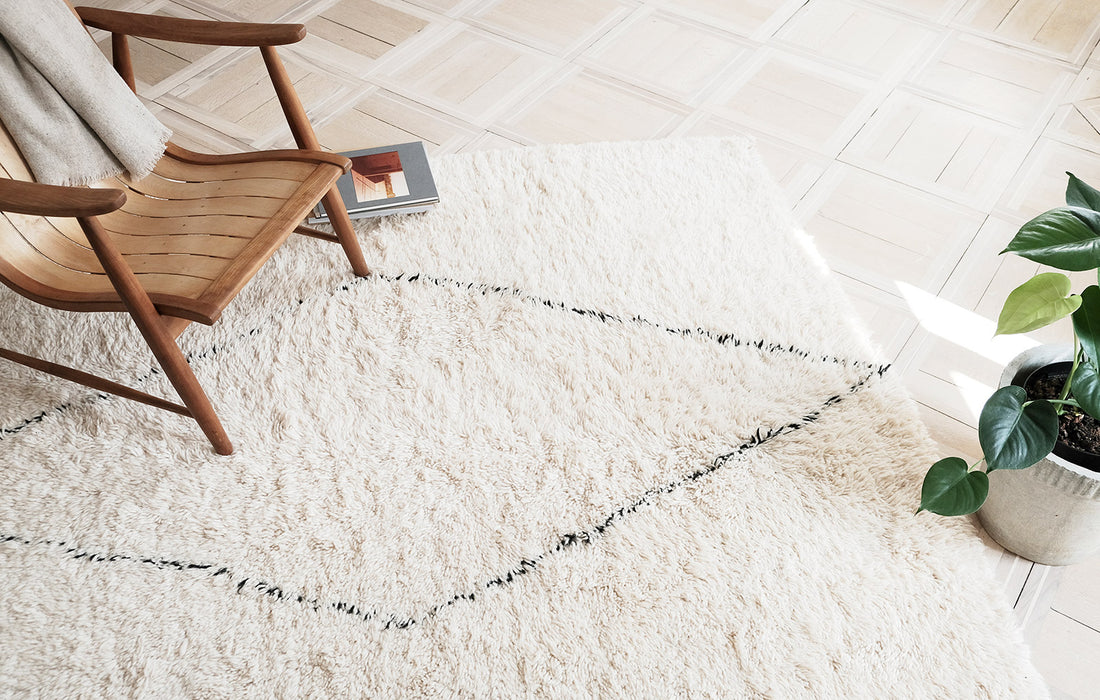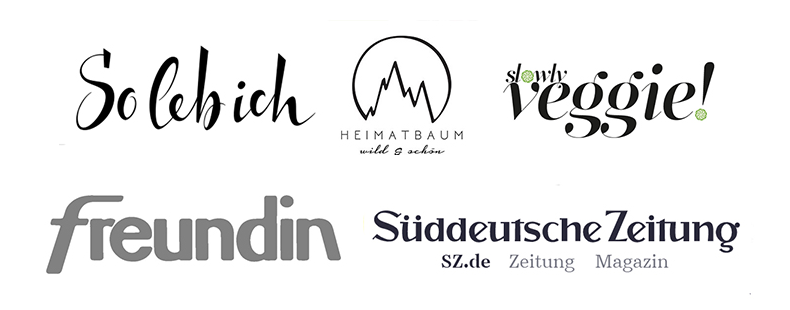This article is intended to be an introduction to the topic and does not claim to be absolutely complete or error-free. We have been working in this area since 2010 and have immersed ourselves deeply in the subject, not least because of our family connections to the Berbers, but also because of our love for what we do. This article was of course also the result of our very personal experience and research. First and foremost, we just want to take you with us and give you a deeper understanding of what exactly a Beni Ourain is, where it comes from and how it is traditionally made or should be made. In our opinion, a simple comparison with a synthetic fake Beni Ourain is not enough here. Even an untrained eye can quickly see the difference. So it is not that difficult to distinguish a “Moroccan wool carpet” from a synthetic carpet. But that shouldn't actually be the point.
You can recognize an original Beni Ourain by the handwork and the real sheep's wool. Correct ?
Yes and no! Basically, this statement is simply too general. When we compare a supposed original with a synthetic imitation, which is "Made in China" or "Made in India", we often see that the supposedly depicted "original" is itself an imitation. The difference is subtler and requires some background knowledge We would like to go back a little and explain why there are so many imitations of the original from Morocco itself.
After the Beni Ourain received a revival a few years ago and appeared quite suddenly in all existing social media channels and magazines, demand naturally shot up to incredible heights, because it is and remains a beautiful carpet. Since the original Beni Ourain only comes from a not particularly large region in the Middle Atlas a little further to the north, it can hardly meet this high demand. So people quickly began to produce Beni Ourain in other regions and larger weaving factories popped up here and there further inland.
The different techniques and their regions
It is important to know that each region and therefore the different Berber tribes that have settled there use very different techniques when making the carpets. Nowadays you often see a so-called “Beni Ourain” with the knotting technique from the Mrirt region, from which the beautiful Amazigh carpet “Beni Mrirt” actually comes, or even a “Beni Ourain” with the same knotting technique as the often colorful Azilal carpets . The knotting technique of the Mrirt is slightly denser, with slightly fewer woven rows than the Beni Ourain, while the typical and original Azilal carpet only has a simple knotting technique (not a double knot), and due to the significantly shorter pile, also ( usually) is a little more densely woven.
The techniques of carpet making have become deeply rooted in the regions, even though the tribes are now spread across the country, their techniques are still deeply rooted in the individual regions. A Beni Ourain, for example, has a double knot, as well as very neat, rounded and finely lined knots.


For example, as is often said, the irregularity of the knots is an indication of its originality is completely wrong. There is still a lot of time, incredible skill and calm in the traditional production at home within the Berber families. The women do not work according to a specific hourly rate, but whenever the family is taken care of and the sheep are out. Only then is the carpet worked on until this special piece of handcraft is finished.
The following is an example: on the left in the picture there is a carpet from a customer who turned to us for help after she had a number of problems with the quality of the carpet (very gray, stains, unsightly surface, extremely strong lint). She had brought the carpet with her from Morocco, but now no longer enjoys it. On the right in the picture is one of our carpets from traditional production.



The women who work in large weaving mills are usually paid per square meter and on very poor terms. So you are forced to work at an incredibly high speed, which often results in the knots being worked incredibly tight and very irregularly (exactly as can be seen in the comparison picture above). The handwork on an original can be seen elsewhere. The pattern occasionally has small irregularities, because when knotting you can make a slight misjudgement here and there; a machine cannot do this. The individual pile threads are not always exactly the same length, as they are only trimmed by hand and not by machine, although machines are rarely used in Morocco. In the end, they result in exactly the typical, completely homogeneous image that the carpet has once it has settled down a bit.

The wool quality
The quality of the wool is another very clear indication of the originality of a Beni Ourain. Here, too, it is of course not enough to simply distinguish between synthetic fibers and real sheep's wool, but rather to understand what influence traditional processing has on the wool. While machine-processed wool is purchased on a large scale in a weaving mill, in traditional production the wool comes from the own family or is purchased at regional markets if necessary. It is not uncommon for the wool to have not been cleaned quite as well by the machine, and is therefore still extremely yellow, which requires it to be bleached again using chemical agents. Sometimes chemical agents are also used during machine cleaning. In both cases the result is wonderfully white wool. In the best case, this wool turns gray after just a few weeks and absorbs a lot of dirt due to the lack of a protective layer of wool grease. In the worst case, a carpet will fall apart during the next cleaning. The feel of the wool is usually a bit rough or feels "hard" and there are still a lot of foreign particles in the wool. It is not uncommon for the smell of wool to be accompanied by a slightly chemical smell. Of course, all of these techniques are not known in traditional production; the wool is cleaned by hand until it is clean.
A real Beni Ourain should therefore have a natural but clean shade of wool, neither too white nor too yellow. It should be soft and not scratchy as the protective film of the natural virgin wool is still present. Subtle differences are of course understandable due to the natural material and handcraft. Cotton is never actually found in an original Beni Ourain.


The high knot density is a quality feature! Correct?
No, actually not or not exclusively. The number of nodes or the density of accounts (and appearance of the nodes) is more of an indication of the region from which it comes. Since it is not the classic Berber carpet (as it has been and continues to be produced for export since the 1960s to this day), but rather the original carpet of the Berber tribes, knots are not usually “thought” here. In order to export and maintain a certain quality, it was necessary for such weaving mills to set certain knot standards. However, this division does not exist among the Berber tribes and was never known.
The Beni Ourain is manufactured using a mixed technique, so it is designed from the ground up so that it always has a few woven rows and then knotted rows again. This creates the typical character of the Beni Ourain, the pile is a little longer (on average 1.5-2.5cm) so that it can settle over time. So it is not a densely knotted Berber with a standing pile, as we know from the Berbers that are made specifically for the foreign market; for these, the number of knots would definitely be a quality feature. As already mentioned above, Beni Mrirt and Azilal carpets are also a little more densely knotted (Beni Mrirt between 120,000-170,000 knots per square meter). So it is not a quality feature in this sense, but can be traced back to the different techniques of the tribes.
If you were to see a section of the back of a Beni Ourain measuring 10x10cm, there would be very few knots overall (70,000-100,000/occasionally 120,000 per sqm). The mixed technique and the slightly longer pile create a very dense fabric. The carpets are approximately 2-3cm thick, but due to the mixed technique they are very soft and like a very thick, heavy blanket. If, in rare cases, the number of knots falls below a certain minimum, it can be assumed that there was simply little wool available. Nevertheless, it is an original, which can be rated a little cheaper due to the smaller amount of wool.
The first part about the production and originality of the Beni Ourain ends here; it should give you a first insight into the still traditional and authentic production. If you are interested in specific points or something is still unclear, we look forward to discussing them in the comments or contacting you via info@touda.de or our contact form. We hope that we have been able to dispel some myths, in any case it is worth investing in an original, we can ensure that families are paid fairly through the close relationship and thus sustainably support ancient crafts.


Would you like to read more about the production of Beni Ourain? You can find a detailed article about it here .
copyright
Please note that all images and texts are subject to our copyright and may not be used without permission. Unfortunately, we often find individual passages of text on other websites or even images. Thank you for your understanding! :)
Sarah & Soufiane from Touda Concept



